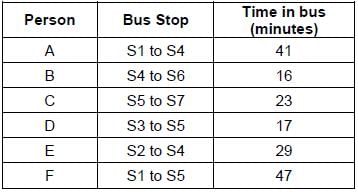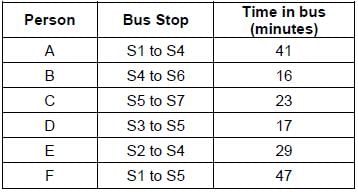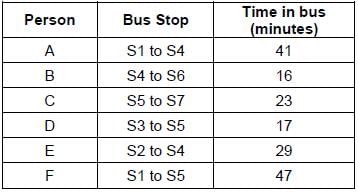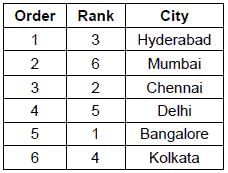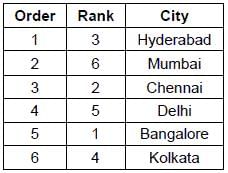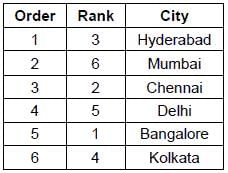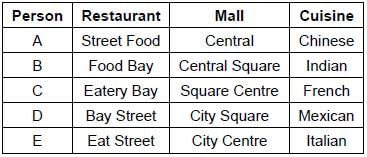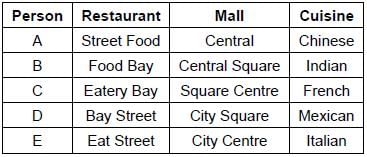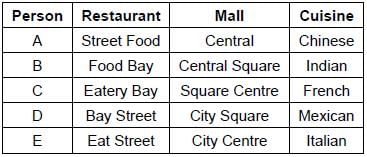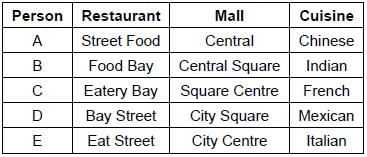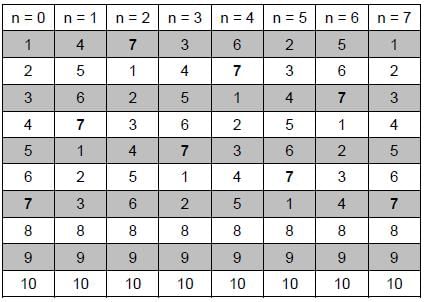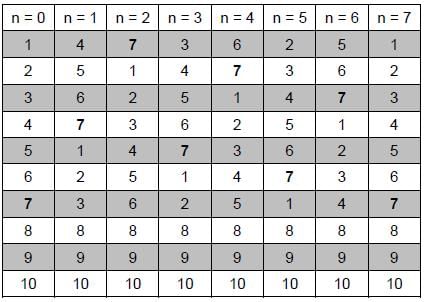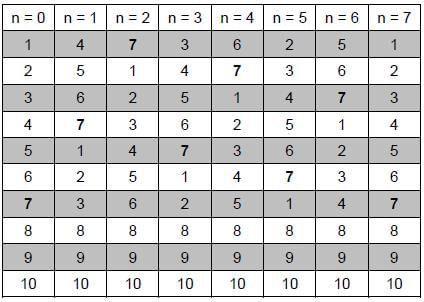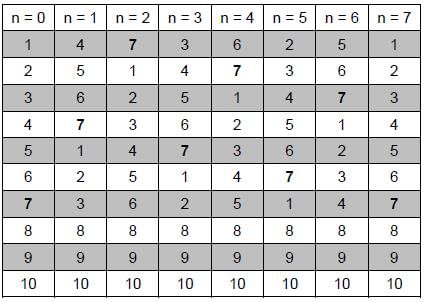CAT DI And LR Mock Test - 1 - CAT MCQ
25 Questions MCQ Test - CAT DI And LR Mock Test - 1
DIRECTIONS for questions: Answer the questions on the basis of the information given below.
On a particular day, six persons, A through F, got into and got down a bus at seven different bus stops - S1 through S7. The bus stopped at the seven stops in the same order as mentioned above. The first table below provides the persons who got into and got down the bus at each bus stop and the second table provides the duration (in minutes) for which each person was in the bus:
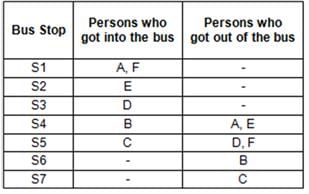
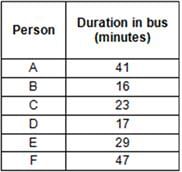
Assume that the duration for which the bus stops at any bus stop is negligible.
Q. How many minutes did the bus take to reach S7 from S6?


DIRECTIONS for questions: Answer the questions on the basis of the information given below.
On a particular day, six persons, A through F, got into and got down a bus at seven different bus stops - S1 through S7. The bus stopped at the seven stops in the same order as mentioned above. The first table below provides the persons who got into and got down the bus at each bus stop and the second table provides the duration (in minutes) for which each person was in the bus:
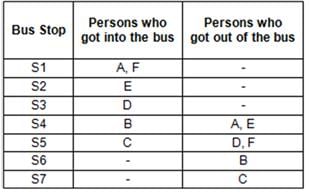
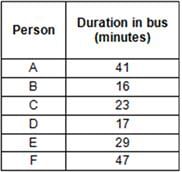
Assume that the duration for which the bus stops at any bus stop is negligible.
Q. For how many minutes were both B and D in the bus?


| 1 Crore+ students have signed up on EduRev. Have you? Download the App |
DIRECTIONS for questions: Answer the questions on the basis of the information given below.
On a particular day, six persons, A through F, got into and got down a bus at seven different bus stops - S1 through S7. The bus stopped at the seven stops in the same order as mentioned above. The first table below provides the persons who got into and got down the bus at each bus stop and the second table provides the duration (in minutes) for which each person was in the bus:
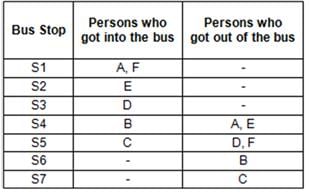
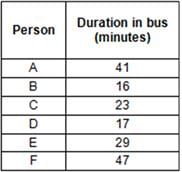
Assume that the duration for which the bus stops at any bus stop is negligible.
Q. For how many minutes were there exactly two persons in the bus?


DIRECTIONS for questions: Answer the questions on the basis of the information given below.
On a particular day, six persons, A through F, got into and got down a bus at seven different bus stops - S1 through S7. The bus stopped at the seven stops in the same order as mentioned above. The first table below provides the persons who got into and got down the bus at each bus stop and the second table provides the duration (in minutes) for which each person was in the bus:

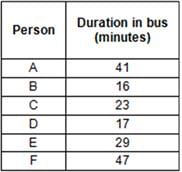
Assume that the duration for which the bus stops at any bus stop is negligible.
Q. For how many minutes were there at least three persons in the bus?
DIRECTIONS for question: Each question is followed by two statements, I and II. Answer each question based on the following instructions: Among the candidates who applied for CAT 2018, 40% are females. One third of these female candidates have anengineering background. What is the total number of candidates with a non-engineering background as a percentage of the total number of applicants for CAT 2018?
I. Two thirds of the male candidates who applied for CAT 2018 have a non-engineering background.
II. Among the applicants for CAT 2018, the number of male candidates with an engineering background was twice the number of female candidates with a non-engineering background.
DIRECTIONS for questions: Answer the questions on the basis of the information given below.
During a particular month, Tarak visited six cities, Delhi, Chennai, Mumbai, Kolkata, Hyderabad and Bangalore, not necessarily in the same order. After visiting the six cities, he ranked the cities, from 1 to 6, based on the order of his preference. The ranks of any two cities that he visited one immediately after the other differed by at least two, while for any two cities whose ranks differed by exactly two, he visited at least one city between them. It is also known that
i. he visited the city ranked three before he visited Chennai.
ii. he visited Kolkata after he visited the city ranked 1.
iii. Mumbai was not the third city that he visited.
iv. Delhi was the fourth city that he visited.
v. he visited the city ranked two before he visited Bangalore.
vi. he visited Hyderabad before he visited Mumbai.
Q. What is the rank of the second city that he visited?
DIRECTIONS for questions: Answer the questions on the basis of the information given below.
During a particular month, Tarak visited six cities, Delhi, Chennai, Mumbai, Kolkata, Hyderabad and Bangalore, not necessarily in the same order. After visiting the six cities, he ranked the cities, from 1 to 6, based on the order of his preference. The ranks of any two cities that he visited one immediately after the other differed by at least two, while for any two cities whose ranks differed by exactly two, he visited at least one city between them. It is also known that
i. he visited the city ranked three before he visited Chennai.
ii. he visited Kolkata after he visited the city ranked 1.
iii. Mumbai was not the third city that he visited.
iv. Delhi was the fourth city that he visited.
v. he visited the city ranked two before he visited Bangalore.
vi. he visited Hyderabad before he visited Mumbai.
Q. What is the rank of Delhi?
DIRECTIONS for questions: Answer the questions on the basis of the information given below.
During a particular month, Tarak visited six cities, Delhi, Chennai, Mumbai, Kolkata, Hyderabad and Bangalore, not necessarily in the same order. After visiting the six cities, he ranked the cities, from 1 to 6, based on the order of his preference. The ranks of any two cities that he visited one immediately after the other differed by at least two, while for any two cities whose ranks differed by exactly two, he visited at least one city between them. It is also known that
i. he visited the city ranked three before he visited Chennai.
ii. he visited Kolkata after he visited the city ranked 1.
iii. Mumbai was not the third city that he visited.
iv. Delhi was the fourth city that he visited.
v. he visited the city ranked two before he visited Bangalore.
vi. he visited Hyderabad before he visited Mumbai.
Q. How many cities did he visit between Chennai and the city ranked three?
DIRECTIONS for questions: Answer the questions on the basis of the information given below.
During a particular month, Tarak visited six cities, Delhi, Chennai, Mumbai, Kolkata, Hyderabad and Bangalore, not necessarily in the same order. After visiting the six cities, he ranked the cities, from 1 to 6, based on the order of his preference. The ranks of any two cities that he visited one immediately after the other differed by at least two, while for any two cities whose ranks differed by exactly two, he visited at least one city between them. It is also known that
i. he visited the city ranked three before he visited Chennai.
ii. he visited Kolkata after he visited the city ranked 1.
iii. Mumbai was not the third city that he visited.
iv. Delhi was the fourth city that he visited.
v. he visited the city ranked two before he visited Bangalore.
vi. he visited Hyderabad before he visited Mumbai.
Q. Which city did Tarak visit between Chennai and the city ranked three?
DIRECTIONS for questions: Answer the questions on the basis of the information given below.
In a school, the students of two classes, Class VI and Class VII, wrote exams in two different subjects - Civics and Economics. Each class comprised exactly 50 students and all the students wrote each of the two exams. The table below provides, for each subject, the average marks of the students, the maximum marks scored by any student and the minimum marks scored by any student in each class.

Q. What is the maximum number of students from Class VII who scored at least 35 marks in each of the two subjects?
DIRECTIONS for questions: Answer the questions on the basis of the information given below.
In a school, the students of two classes, Class VI and Class VII, wrote exams in two different subjects - Civics and Economics. Each class comprised exactly 50 students and all the students wrote each of the two exams. The table below provides, for each subject, the average marks of the students, the maximum marks scored by any student and the minimum marks scored by any student in each class.

Q. What is the maximum number of students from Class VI whose score in Civics was the same as that in Economics?
DIRECTIONS for questions: Answer the questions on the basis of the information given below.
In a school, the students of two classes, Class VI and Class VII, wrote exams in two different subjects - Civics and Economics. Each class comprised exactly 50 students and all the students wrote each of the two exams. The table below provides, for each subject, the average marks of the students, the maximum marks scored by any student and the minimummarks scored by any student in each class.

Q. If the number of students from Class VI whose score in Civics was the same as that in Economics is the maximum possible, what is the maximum number of students who scored 46 marks in Civics?
DIRECTIONS for questions: Answer the questions on the basis of the information given below.
In a school, the students of two classes, Class VI and Class VII, wrote exams in two different subjects - Civics and Economics. Each class comprised exactly 50 students and all the students wrote each of the two exams. The table below provides, for each subject, the average marks of the students, the maximum marks scored by any student and the minimummarks scored by any student in each class.

Q. For which class is it possible that the second highest mark scored by any student in one of the two subjects is lower than the second lowest mark scored by any student in the other subject?
DIRECTIONS for question: Select the correct alternative from the given choices.
Professor Theodore Bumblebee of IIM-A gave five assignments − I, II, III, IV and V − to five of his students − Super Subbu, Cunning Chetan, Lazy Laxman, Morose Mary and Reckless Rani, as part of a group assignment. The following table shows the times (in hours) taken by each of the students to complete the assignments:

In a group assignment, all the assignments given have to be completed and it is not necessary that every person does each and every assignment. Thus, this group arrives at a consensus and decides that each of them would do exactly one of the assignments.
Q. What is the cumulative time spent by all the students in completing the group assignment, if they finish it in the least possible time?
DIRECTIONS for questions: Answer the questions on the basis of the information given below.
In a city, there are exactly five different malls - City Centre, Central, Central Square, City Square and Square Central. Each mall has a different restaurant among Eat Street, Eatery Bay, Bay Street, Streetfood and Food Bay. Further, each restaurant serves a different cuisine among Indian, Chinese, Italian, Mexican and French. On a particular day, each of five persons, A through E, visited a different restaurant among the ones mentioned above. It is also known that
i. Food Bay is in Central Square, while D visited City Square.
ii. the restaurant that serves Indian cuisine was visited by B, while the Bay Street does not serve French cuisine.
iii. E, who visited Eat Street, did not visit the restaurant that serves Mexican cuisine.
iv. Square Central has the restaurant which serves French cuisine and this was visited by C.
v. Streetfood, which is not in City Centre, serves Chinese cuisine and this was visited by A.
Q. Which mall did B visit?
DIRECTIONS for questions: Answer the questions on the basis of the information given below.
In a city, there are exactly five different malls - City Centre, Central, Central Square, City Square and Square Central. Each mall has a different restaurant among Eat Street, Eatery Bay, Bay Street, Streetfood and Food Bay. Further, each restaurant serves a different cuisine among Indian, Chinese, Italian, Mexican and French. On a particular day, each of five persons, A through E, visited a different restaurant among the ones mentioned above. It is also known that
i. Food Bay is in Central Square, while D visited City Square.
ii. the restaurant that serves Indian cuisine was visited by B, while the Bay Street does not serve French cuisine.
iii. E, who visited Eat Street, did not visit the restaurant that serves Mexican cuisine.
iv. Square Central has the restaurant which serves French cuisine and this was visited by C.
v. Streetfood, which is not in City Centre, serves Chinese cuisine and this was visited by A.
Q. Which cuisine does the restaurant that D visited serve?
DIRECTIONS for questions: Answer the questions on the basis of the information given below.
In a city, there are exactly five different malls - City Centre, Central, Central Square, City Square and Square Central. Each mall has a different restaurant among Eat Street, Eatery Bay, Bay Street, Streetfood and Food Bay. Further, each restaurant serves a different cuisine among Indian, Chinese, Italian, Mexican and French. On a particular day, each of five persons, A through E, visited a different restaurant among the ones mentioned above. It is also known that
i. Food Bay is in Central Square, while D visited City Square.
ii. the restaurant that serves Indian cuisine was visited by B, while the Bay Street does not serve French cuisine.
iii. E, who visited Eat Street, did not visit the restaurant that serves Mexican cuisine.
iv. Square Central has the restaurant which serves French cuisine and this was visited by C.
v. Streetfood, which is not in City Centre, serves Chinese cuisine and this was visited by A.
Q. Which cuisine does the restaurant that D visited serve?
DIRECTIONS for questions: Answer the questions on the basis of the information given below.
In a city, there are exactly five different malls - City Centre, Central, Central Square, City Square and Square Central. Each mall has a different restaurant among Eat Street, Eatery Bay, Bay Street, Streetfood and Food Bay. Further, each restaurant serves a different cuisine among Indian, Chinese, Italian, Mexican and French. On a particular day, each of five persons, A through E, visited a different restaurant among the ones mentioned above. It is also known that
i. Food Bay is in Central Square, while D visited City Square.
ii. the restaurant that serves Indian cuisine was visited by B, while the Bay Street does not serve French cuisine.
iii. E, who visited Eat Street, did not visit the restaurant that serves Mexican cuisine.
iv. Square Central has the restaurant which serves French cuisine and this was visited by C.
v. Streetfood, which is not in City Centre, serves Chinese cuisine and this was visited by A.
Q. Which cuisine does the restaurant in Central serve?
DIRECTIONS for questions: Answer the questions on the basis of the information given below.
Rahul and Kiran were playing a game in which Rahul distributes ten cards, numbered 1 through 10, equally between Kiran and him. Rahul initially forms a stack with these ten cards, shuffles them forn times, each time taking four cards which are exactly in the middle of the stack and placing them on top of the stack in the same order. He then distributes the stack of ten cards such that he first gives Kiran the top most card and then takes the next for himself; he gives the next card to Kiran and takes one for himself and so on until all the cards are distributed. After distributing all the cards, the person who has the card numbered 7 is declared the winner.
When Rahul initially formed a stack, the cards were present in the stack in the ascending order of their numbers, with card numbered 1 at the top and card numbered 10 at the bottom.
Q. For which of the following values of n will Rahul win?
DIRECTIONS for questions: Answer the questions on the basis of the information given below.
Rahul and Kiran were playing a game in which Rahul distributes ten cards, numbered 1 through 10, equally between Kiran and him. Rahul initially forms a stack with these ten cards, shuffles them forn times, each time taking four cards which are exactly in the middle of the stack and placing them on top of the stack in the same order. He then distributes the stack of ten cards such that he first gives Kiran the top most card and then takes the next for himself; he gives the next card to Kiran and takes one for himself and so on until all the cards are distributed. After distributing all the cards, the person who has the card numbered 7 is declared the winner.
When Rahul initially formed a stack, the cards were present in the stack in the ascending order of their numbers, with card numbered 1 at the top and card numbered 10 at the bottom.
Q. Which of the following pair of cards can Rahul never have simultaneously?
DIRECTIONS for questions: Answer the questions on the basis of the information given below.
Rahul and Kiran were playing a game in which Rahul distributes ten cards, numbered 1 through 10, equally between Kiran and him. Rahul initially forms a stack with these ten cards, shuffles them forn times, each time taking four cards which are exactly in the middle of the stack and placing them on top of the stack in the same order. He then distributes the stack of ten cards such that he first gives Kiran the top most card and then takes the next for himself; he gives the next card to Kiran and takes one for himself and so on until all the cards are distributed. After distributing all the cards, the person who has the card numbered 7 is declared the winner.
When Rahul initially formed a stack, the cards were present in the stack in the ascending order of their numbers, with card numbered 1 at the top and card numbered 10 at the bottom.
Q. If Kiran has two cards with consecutive numbers but was not the winner of the game, then which of the following will Rahul definitely not have?
DIRECTIONS for questions: Answer the questions on the basis of the information given below.
Rahul and Kiran were playing a game in which Rahul distributes ten cards, numbered 1 through 10, equally between Kiran and him. Rahul initially forms a stack with these ten cards, shuffles them forn times, each time taking four cards which are exactly in the middle of the stack and placing them on top of the stack in the same order. He then distributes the stack of ten cards such that he first gives Kiran the top most card and then takes the next for himself; he gives the next card to Kiran and takes one for himself and so on until all the cards are distributed. After distributing all the cards, the person who has the card numbered 7 is declared the winner.
When Rahul initially formed a stack, the cards were present in the stack in the ascending order of their numbers, with card numbered 1 at the top and card numbered 10 at the bottom.
Q. If the sum of the cards that Kiran has is the lowest possible, which of the following cards will Rahul have?
DIRECTIONS for question: Select the correct alternative from the given choices.
At a multiplex, the following six movies are scheduled as shown in the table given below:

You wish to see all the movies in a single day. If you need to have a break from 4:00 p.m. to 6:00 p.m., then which of the following is true?
DIRECTIONS for questions: Answer the questions on the basis of the information given below.
Five teams - A through E - participated in a hockey tournament in which each team played against each of the other teams exactly once. In any match, the winning team is awarded four points and the losing team no points. In case of a draw, the two teams are awarded one point each. At the end of the tournament, B had two points more than E, which, in turn, had two points more than A, which, in turn, had one point less than D, which, in turn, had three points more than C.
Q. What is the result of the match between C and D?
DIRECTIONS for questions: Answer the questions on the basis of the information given below.
Five teams - A through E - participated in a hockey tournament in which each team played against each of the other teams exactly once. In any match, the winning team is awarded four points and the losing team no points. In case of a draw, the two teams are awarded one point each. At the end of the tournament, B had two points more than E, which, in turn, had two points more than A, which, in turn, had one point less than D, which, in turn, had three points more than C.
Q. If E drew the match against A, which of the following teams won against D?


